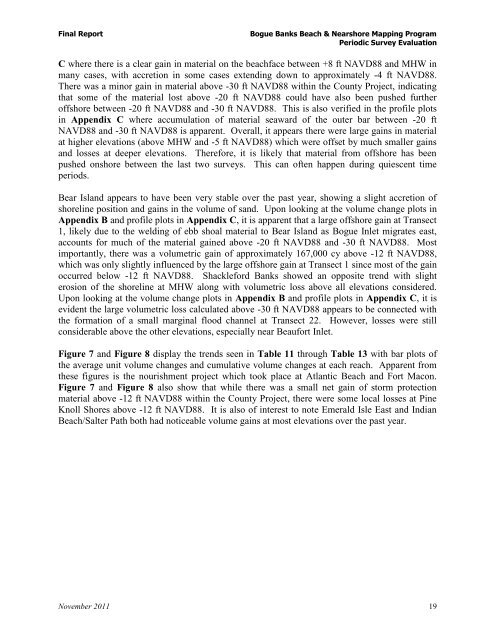Bogue Banks Beach - Carteret County Shore Protection Office
Bogue Banks Beach - Carteret County Shore Protection Office
Bogue Banks Beach - Carteret County Shore Protection Office
Create successful ePaper yourself
Turn your PDF publications into a flip-book with our unique Google optimized e-Paper software.
Final Report <strong>Bogue</strong> <strong>Banks</strong> <strong>Beach</strong> & Nearshore Mapping Program<br />
Periodic Survey Evaluation<br />
C where there is a clear gain in material on the beachface between +8 ft NAVD88 and MHW in<br />
many cases, with accretion in some cases extending down to approximately -4 ft NAVD88.<br />
There was a minor gain in material above -30 ft NAVD88 within the <strong>County</strong> Project, indicating<br />
that some of the material lost above -20 ft NAVD88 could have also been pushed further<br />
offshore between -20 ft NAVD88 and -30 ft NAVD88. This is also verified in the profile plots<br />
in Appendix C where accumulation of material seaward of the outer bar between -20 ft<br />
NAVD88 and -30 ft NAVD88 is apparent. Overall, it appears there were large gains in material<br />
at higher elevations (above MHW and -5 ft NAVD88) which were offset by much smaller gains<br />
and losses at deeper elevations. Therefore, it is likely that material from offshore has been<br />
pushed onshore between the last two surveys. This can often happen during quiescent time<br />
periods.<br />
Bear Island appears to have been very stable over the past year, showing a slight accretion of<br />
shoreline position and gains in the volume of sand. Upon looking at the volume change plots in<br />
Appendix B and profile plots in Appendix C, it is apparent that a large offshore gain at Transect<br />
1, likely due to the welding of ebb shoal material to Bear Island as <strong>Bogue</strong> Inlet migrates east,<br />
accounts for much of the material gained above -20 ft NAVD88 and -30 ft NAVD88. Most<br />
importantly, there was a volumetric gain of approximately 167,000 cy above -12 ft NAVD88,<br />
which was only slightly influenced by the large offshore gain at Transect 1 since most of the gain<br />
occurred below -12 ft NAVD88. Shackleford <strong>Banks</strong> showed an opposite trend with slight<br />
erosion of the shoreline at MHW along with volumetric loss above all elevations considered.<br />
Upon looking at the volume change plots in Appendix B and profile plots in Appendix C, it is<br />
evident the large volumetric loss calculated above -30 ft NAVD88 appears to be connected with<br />
the formation of a small marginal flood channel at Transect 22. However, losses were still<br />
considerable above the other elevations, especially near Beaufort Inlet.<br />
Figure 7 and Figure 8 display the trends seen in Table 11 through Table 13 with bar plots of<br />
the average unit volume changes and cumulative volume changes at each reach. Apparent from<br />
these figures is the nourishment project which took place at Atlantic <strong>Beach</strong> and Fort Macon.<br />
Figure 7 and Figure 8 also show that while there was a small net gain of storm protection<br />
material above -12 ft NAVD88 within the <strong>County</strong> Project, there were some local losses at Pine<br />
Knoll <strong>Shore</strong>s above -12 ft NAVD88. It is also of interest to note Emerald Isle East and Indian<br />
<strong>Beach</strong>/Salter Path both had noticeable volume gains at most elevations over the past year.<br />
November 2011 19


